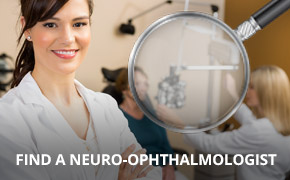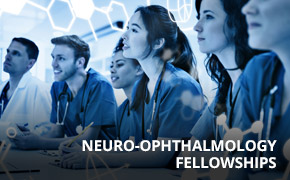QUICK LINKS: Practice Support Tools | Patients | Find a Neuro-Ophthalmologist | NOVEL | YONO Portal | Our Journal | Fellowships
Double Vision
Patients: Download as PDF
Clinicians: Download as PDF
What is double vision?
Double vision, also known as diplopia, occurs when a single object is seen as two images at the same time. Double vision has many causes and is a frequent reason for patients to see an eye doctor or a specialist such as a neurologist or neuro-ophthalmologist.
The most important observation to make when having double vision is whether it goes away with covering either eye. If the double vision is present in one eye by itself, this is monocular double vision. Alternatively, if the double vision resolves completely with closure of either eye, and is only present with both eyes open, this is binocular double vision.
Monocular double vision is almost always caused by a problem with the way light is focused by the front of the eye onto the retina (the back part of the eye that senses light and creates an image to be sent to the brain). When light is not focused perfectly on the retina, the result is blurry vision, and sometimes the light can separate into two separate images. This type of double vision is often described as seeing a “ghost” or “shadow” image next to the main image. Monocular double vision is caused by an eye problem, not a problem in the brain or nerves. Common causes for monocular double vision include dry eyes, cataracts, or the need for eyeglasses or an eyeglasses update. Less common causes include scarring of the cornea (clear front part of the eye) or even certain retina conditions such as retinal swelling or membrane. Your eye doctor can help determine which eye condition is causing your monocular double vision and will be able to recommend the best treatment option.
Binocular double vision is always a symptom of eye misalignment (also known as strabismus). In other words, each eye may be pointing in a slightly different direction. This type of double vision goes away with closing either eye because the image from one eye or the other is eliminated. There are various causes of eye misalignment, including problems of the eye sockets (orbits), eye muscles, nerves that control the eye muscles (“cranial nerves”), a problem with communication between the nerves and their eye muscles, or problems with the brain itself.
Many people have eye misalignment that is not due to any of the above examples, but is instead due to being born with a slight misalignment that the brain usually compensates for to line up the eyes. This is called a congenital strabismus. Sometimes a subtle misalignment may decompensate and become more symptomatic with age.
Why do I need to see a neuro-ophthalmologist?
Neuro-ophthalmologists are experienced and trained in evaluating visual symptoms and determining their cause, including double vision. The neuro-ophthalmological examination will include an examination of eye movements and eye alignment to determine which part of the system controlling eye movements has been affected. A doctor may also ask about associated pain, droopy eyelid, pupil size asymmetry, numbness, weakness, imbalance, dizziness or trouble with speech or swallowing. It can also be helpful to know if the double vision comes and goes or is worse looking in a particular direction or up close compared to far away. These answers can help determine the location of the problem along the pathways that keep our eyes aligned, and subsequently the cause. At the end of the visit, the neuro-ophthalmologist will be able to determine if additional testing is needed, such as imaging of the brain, blood vessels or eye muscles, blood tests, or other procedures.
Is there treatment for double vision?
The treatment of double vision depends on the underlying cause, but first the cause needs to be identified and treated, if possible. Sometimes double vision can improve without treatment. During the initial stages, it may be easiest to close or cover one eye, as with a patch or tape on a glasses lens, to eliminate one of the images. In adults, it doesn’t matter which eye is patched, so this depends on comfort and clarity of vision. In young children under ten, it is important to switch off which eye is patched so visual development is not affected. If there is persistent double vision, treatment options may include the addition of prism to glasses (a “stick-on” prism can be applied or prisms can be ground into the lenses), surgery on eye muscles or, in some cases, medications. Prisms bend light, shifting images so that they align. Eye muscle surgery moves the position of muscles on the eye or changes the length of the muscle to move the eyes into alignment.
Additional Reading/Resources
- Eye Wiki
Basic Approach to Diplopia - American Academy of Ophthalmology
What Is Adult Strabismus?
What Is Microvascular Cranial Nerve Palsy?
Copyright © 2024. North American Neuro-Ophthalmology Society. All rights reserved.
This information was developed collaboratively by the Patient Information Committee of the North American Neuro-Ophthalmology Society. This has been written by neuro-ophthalmologists and has been edited, updated, and peer-reviewed by multiple neuro-ophthalmologists. The views expressed in this brochure are of the contributors and not their employers or other organizations. Please note we have made every effort to ensure the content of this is correct at time of publication, but remember that information about the condition and drugs may change. Major revisions are performed on a periodic basis.
This information is produced and made available “as is” without warranty and for informational and educational purposes only and do not constitute, and should not be used as a substitute for, medical advice, diagnosis, or treatment. Patients and other members of the general public should always seek the advice of a physician or other qualified healthcare professional regarding personal health or medical conditions.














_250x90.png)

_157x155.png)